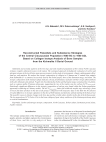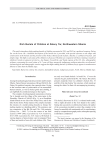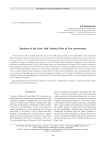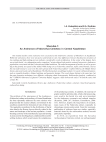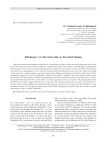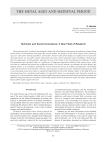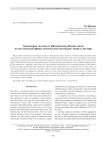The metal ages and medieval period. Рубрика в журнале - Archaeology, Ethnology & Anthropology of Eurasia

Статья научная
A multidisciplinary analysis of ceramics from six sites of the Surgut variant of the Kulaika culture at Barsova Gora was made. Technology was assessed using traceological, petrographic, and X-ray phase analyses. At all the sites, the potters used ferruginous clays tempered with grus, grog, sand, and organic material. Fragments in the clay were either rounded, as in sand, or coarse, as in grus. The sand was mainly represented by feldspar and quartz, suggesting that this type of raw material was extracted from nearby non-metallic mineral deposits. The grus consisted of fragments of basaltoids, amphiboles, and pyroxenes, evidencing that it came from igneous common rocks associated with the Surgut volcanic fi eld and spread over a large area. Rocks were probably mined near settlements, perhaps on the floodplain of the Ob. Grog in all the samples was similar to the basic clay in terms of its composition. Three groups of sites were identified, differing in the composition of the clay of which the ceramics were made. This may indicate the presence of several groups within the Iron Age Kulaika population, utilizing various sources of clay.
Бесплатно
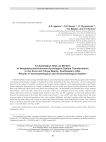
Remain s of tapestry from a Xiongnu (early 1st century ad) burial in mound 22 at Noin-Ula
Статья обзорная
Бесплатно
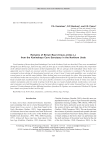
Remains of brown bear (Ursus arctos L.) from the Kaninskaya cave sanctuary in the Northern Urals
Статья
Бесплатно
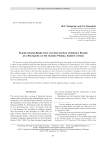
Статья
We describe a group of Egyptian faience scarabs unearthed from the necropolis on the Iluraton Plateau, Eastern Crimea, by the expedition from the State Museum of the History of Religion (St. Petersburg) in 1987–1990. Artifacts made of so-called Egyptian faience were found in eight of the sixty-two burials—those of g irls aged below 1.5, dating to the 1st to early 2nd centuries AD. The most numerous among the faience items were beads in the form of scarabs. The analysis shows them to fall into three groups in terms of presence and nature of images on the reverse side: those without images (3 spec.), those with abstract images (3 spec.), and those with anthropo-zoomorphic images (2 spec.). In two cases, representations point to specifi c Egyptian workshops. Scarabs in girls’ burials of the Roman period elaborate on the thanatological imagery, which originated among the Scythian-Saka tribes of Eurasia in the mid-1st millennium BC.
Бесплатно
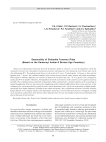
Seasonality of Sintashta funerary rites (based on the Kamennyi ambar-5 Bronze Age cemetery)
Статья научная
Based on archaeological materials from the Kamennyi Ambar-5 cemetery, we test the hypothesis about the connection between the seasonality of pastoral practices and funerary rites during the Late Bronze Age (early 2nd millennium BC). We studied growth layers in the teeth of 24 cows, 19 sheep/goats, 14 horses, a dog, and ten humans from 17 graves. We combined samples from various species from the same contexts into eight assemblages. With regard to animals, differences in seasons of death were revealed only once. 70 % of graves were arranged in spring and 30 % in autumn. Therefore, the hypothesis about the seasonal use of the cemetery can be supported at least partially. The contemporaneous settlement of Kamennyi Ambar demonstrates a similar tendency in the seasonality of animal slaughtering. However, the reasons for slaughtering at the settlement differed from those in the cemetery. At the settlement site, it was motivated by practical needs, and in themortuary site, only by the seasonality of human deaths, specifically Ьy a higher frequency of deaths in late winter and spring. Also, postmortem selection is possiЬle, whereЬy kurgan burials were arranged only for some individuals. In practice, several of the above factors overlapped, resulting in an anomalous composition of the buried cohort (disproportion of sexes and a higher proportion of individuals who died at the peak of vital activity).
Бесплатно
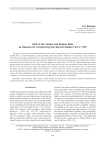
Shift of the Yenisei and Abakan Beds as Reasons for Constructing the Second Abakan Fort in 1707
Статья научная
The study explores the reasons behind the relocation of the construction site for Fort Abakan from the mouth of the Abakan River, as initially planned, to the right bank of the Yenisei River, between two mountains, Unyuk and Turan. The shift of sand ridges, damming these rivers and changing their beds, is examined, and the locations of the projected forts are described. Written sources suggest that the Abakan and Yenisei beds as related systems changed their positions simultaneously, likely between 1691 and 1697 and definitely no earlier than 700–400 BC. Modern hydrological data suggest that processes that occurred in the region in the Early Modern Age were essentially like those that occurred in the Early Iron Age. The earlier date of the Abakan bed’s change is evidenced by the destruction of the 1st millennium BC Tagar sites near Sartykov village on the Abakan. At present, the Yenisei makes an abrupt eastward turn in that place, following the general direction of rivers in the region. D.A. Klements’s idea that after leaving the Western Sayan canyon, the Yenisei had flowed westwards is rejected. The change of location for the prospective fort was caused by the evolution of riverine systems of Western Siberia, specifically by the shift in the Abakan bed.
Бесплатно
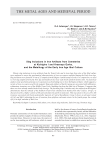
Статья научная
Silicate slag inclusions in iron artifacts from the Trans-Urals and in iron slags from sites of the Itkul culture were analyzed to assess the geochemical characteristics of iron ore sources exploited during the Early Iron Age. Slag inclusions were found in 19 out of 25 samples from Kichigino I and Krasnaya Gorka. For comparison, we used 12 iron slag samples from Early Iron Age and medieval sites near Lake Irtysh and from Zotino mine. Via statistical analysis, four geochemical groups were separated, each including one or more Kichigino artifacts, which suggests a variety of iron ore sources used by the nomads. Slags and artifacts of the first group are associated with infiltration-sedimentary ironstone ores of the Middle Trans-Urals. Smithing slag from the Itkul site of Shatanov V suggests that these ores were already smelted in the Early Iron Age. The fact that group 1 includes only one artifact from Kichigino I demonstrates that the nomads of the Southern Trans-Urals obtained iron mainly from other sources. Group 2 is characterized by a higher content of Mn and sometimes Ba and S in inclusions. This may attest to the use of Fe-Mn ironstone associated with barite-polymetallic deposits of Central Kazakhstan. Group 3 shows an elevated content of CaO and MgO, indicating the use of ironstone from platform carbonate strata. In the fourth group, the content of K2O is high, and that of MnO, low.
Бесплатно
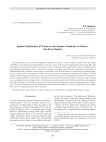
Spatial Distribution of Finds on the Eastern Outskirts of Poltse I, the Amur Region
Статья научная
On the occasion of the 60th anniversary of the first excavations at Poltse I The study addresses the spatial arrangement of features at Poltse I—a Poltse culture settlement near the village of Kukelevo. An analysis of past scholarship reveals the sources of the modern understanding of the geographic and topographic location of the site and of its present condition. Although Poltse I and Poltse II, which is located nearby, were damaged by plowing in 1968, it is possible to continue excavations and obtain new information. On the basis of published materials, field plans in the archives, and artifacts at the SB RAS Institute of Archaeology and Ethnography, the first complete plan of excavations at Poltse I has been prepared, showing the arrangement of dwellings. Certain features of their design are described. Ceramic vessels found in each of the ten dwellings are listed. The vessels were placed along the perimeter of the interior, leaving free space around the central hearth and a passage to the exit. Most were concentrated in six dwellings. Only a few of them were used in everyday life, while most could have been destined for trade and barter. The abundance of ceramics (965 specimens and numerous separate fragments) makes Poltse I a key source for information on pottery manufacture, subsistence, and cultural ties. So far, it is impossible to say whether the vessels were manufactured in situ or imported.
Бесплатно
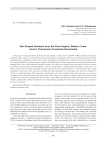
Star-shaped pendants from the Perm region, Western Urals: Hunnic polychrome ornaments reanimated
Статья
Бесплатно
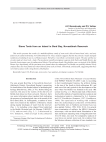
Stone Tools from an Island in Berd Bay, Novosibirsk Reservoir
Статья научная
This article presents the results of a multidisciplinary study of stone tools (discoid mace-head, adze, and axe) found on an island in Berd Bay, Novosibirsk Reservoir. Trace analysis suggests that the mace-head is made of fragile sandstone, precluding its use as a striking weapon. Therefore, it was likely a ceremonial weapon. The adze and the axe are also made of a local rock—shale. The specimens resemble prestigious weapons of the Early and Middle Bronze Age from the forest-steppe zone of southwestern Siberia. Discoid mace-heads, like globular ones, are typical of the Middle Bronze Age. Importantly, all the specimens were found where the submerged Fort Berdsk was possibly situated. Early artifacts have also been found near other Siberian forts such as Tomsk, Umrevinsky, and Sayansk, suggesting that these were built at places with a long history of habitation.
Бесплатно
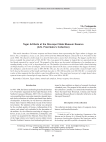
Tagar artifacts at the Stavropol state museum reserve (G.N. Prozritelev's collection)
Статья обзорная
Бесплатно

Textiles from the Ust-Voikary hillfort site (based on materials from 2012–2016 excavations)
Статья научная
The article describes 366 samples of clothing (some of them attributable), collected in 2012–2016 from cultural layers of the 15th to middle 18th centuries at the Ust-Voikary hillfort site in the subarctic zone of Western Siberia. We provide technological characteristics: size, state of preservation, color, properties of threads and fibers, interlacing system, technological errors, cut, and traces of repair. Both animal and plant fibers are present, and plain and twill weaving are attested. Ethnographic and zoological data provide information on the textile technologies used by residents of the polar zone of Western Siberia, and allow us to compare them with those known from other sites. We conclude that types of textiles for clothing remained virtually the same from the 15th to the 18th centuries. Fabrics, mostly woolen, were imported.
Бесплатно

